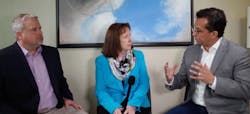Schneider Electric & AlphaStruxure Talk Local Production, Efficient Consumption, Smart Acquisition
In an interview with Juan Macias, CEO of AlphaStruxure, and Mark Feasal, vice president, smart grid, Schneider Electric, we learn about the microgrid and local energy strategies being pursued by the aligned companies. Elisa Wood, Microgrid Knowledge editor-in-chief, interviewed Macias and Feasel at Microgrid 2019 in San Diego.
Elisa Wood, Microgrid Knowledge editor-in-chief, kicks off the video interview by asking AlphaStruxure’s Macias why the new company is important. A joint venture of Schneider Electric and the Carlyle Group, AlphaStruxure was recently formed to pursue a $1 trillion underinvestment in US infrastructure and a fast-growing market for microgrids. Funding comes from the Carlyle Global Infrastructure Fund, which focuses on developing new electrical and energy infrastructure in the US.
Macias describes two large microgrid projects the company is working on, including New York Gov. Andrew Cuomo’s $13 billion JFK Airport modernization, which incorporates multiple microgrids to move the facility toward 100% renewable energy within the next decade.
AlphaStruxure also is working on the Lone Star Ports Harbor Island Crude Export Terminal, under development in Corpus Christi, Texas, which also will use microgrid technology.
AlphaStruxure was formed to pursue a $1 trillion underinvestment in US infrastructure and a fast-growing market for microgrids.
Macias points out in the Microgrid 2019 interview that the joint venture also will offer energy-as-a-service (EaaS) contracts. AlphaStruxure has worked with Dynamic Energy Networks, another company backed by the Carlyle Group, to incorporate EaaS into its offerings, via the tech expertise of AlphaStruxure and the financial capabilities of the Carlyle Group, Macias explains.
Local, efficient, smart
Next, Schneider Electric’s Mark Feasal describes EaaS as the story of energy that is “smartly acquired, locally produced and efficiently consumed.”
These are elements that are particularly important to the transportation segment, Feasel points out.
First, local energy production is key to the EaaS “story,” he says.
“Generating electricity locally allows you to be very prescriptive on the sustainability and resilience that are right for you. You might be able to get that off the grid, but you might not,” Feasel says. “Augmenting the grid with what you can do on-site gives you a lot of optionality.”
As for the “smartly acquired” piece, Feasel points out that some types of energy may make more sense to consume off the grid.
“Not just physical energy, but also maybe sustainability, contractual energy, like purchase power agreements, etc.,” Feasel says.
He provides this example for the alternate scenario: If you are operating a fleet, and you are starting to change from internal combustion engines to electric vehicles, you may not want to power the electric vehicle batteries with grid power generated by fossil fuels.
Mixing it up
You may want to use local green energy or a mix that includes green energy from your utility, or if you are in an open market, from competitive companies via contractual agreement.
“We see all three of those elements, whether it’s local production, efficient consumption or smart acquisition as being key parts of what the transportation segment is going to need,” Feasel says.
To drive this point home, Feasel paints another picture. If you are way out at the end of a distribution feeder, it doesn’t necessarily make sense to augment the grid, in the case of putting in a charging station for an electric vehicle hub, for example. In this case, local energy production is a better answer.
Feasel says, “You can dial the needs in right at that spot and not worry about replacing all the miles and miles of distribution systems in between. It does also make sense to build upon and augment our existing grid — both these things will happen at the same time.”
Track microgrid news and trends as they emerge. Subscribe to the free Microgrid Knowledge newsletter.
